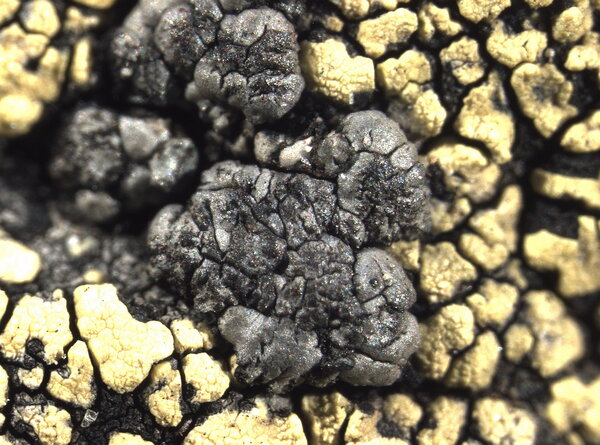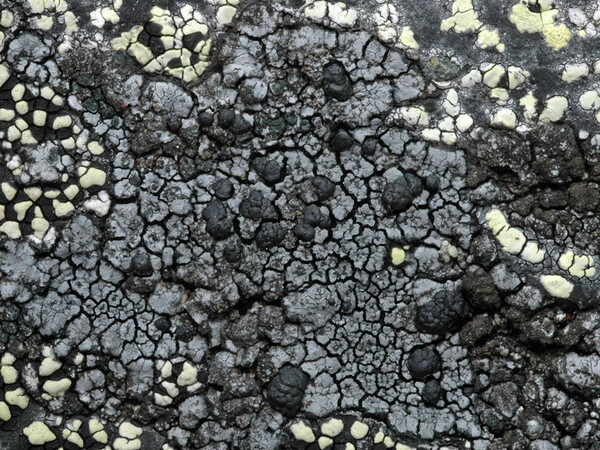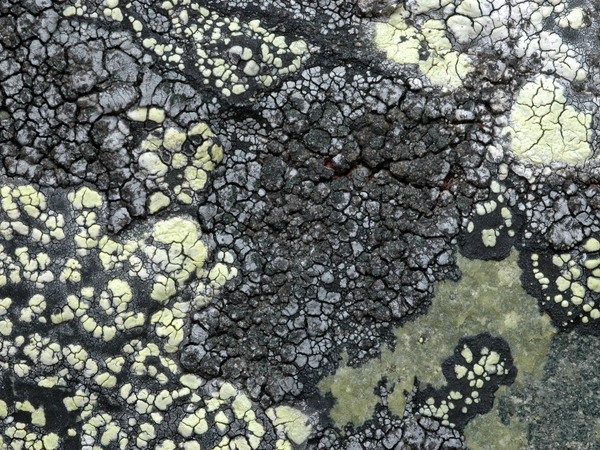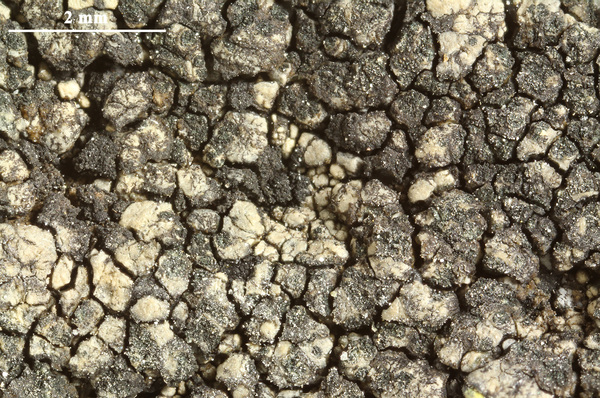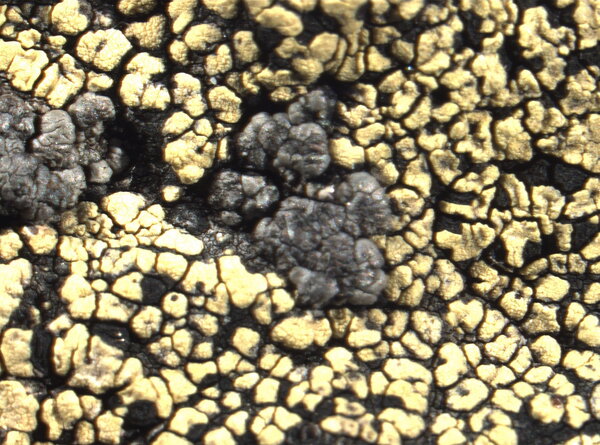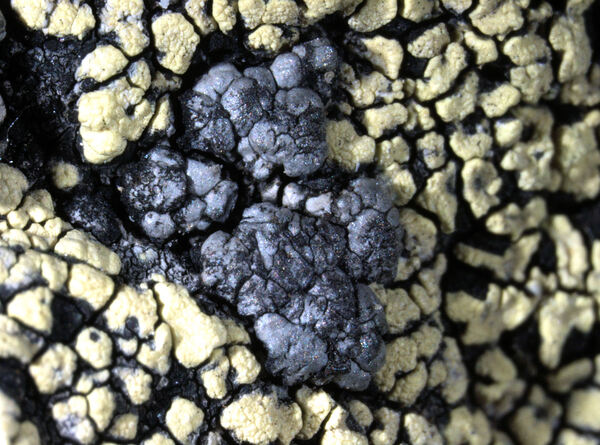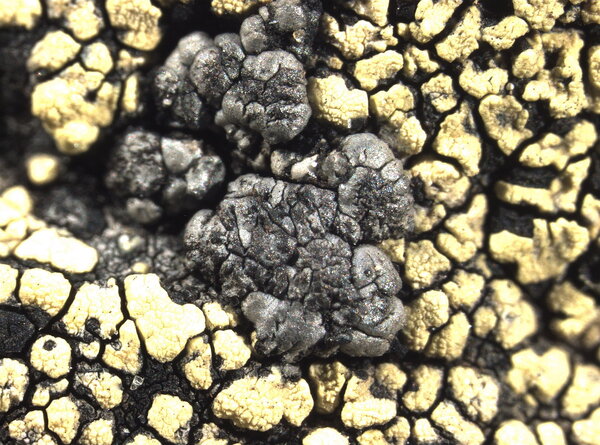Miriquidica nigroleprosa (Vain.) Hertel & Rambold var. nigroleprosa
Mitt. bot. Staatss. München, 23: 388, 1987. Basionym: Lecanora nigroleprosa Vain. - Meddeland. Soc. Fauna Fl. Fenn., 10: 208-209, 1883.
Synonyms: Lecidea nigroleprosa (Vain.) H. Magn.; Miriquidica nigroleprosa (Vain.) Hertel & Rambold
Distribution: N - Frl (Tretiach & Hafellner 2000, Hertel & Schuhwerk 2010). C - Sar. S - Cal (Hafellner & al. 2014).
Description: Thallus crustose, episubstratic, medium to dark grey, rarely cream to brownish white, somehow glossy, rimose-areolate, usually < 1 mm thick, forming up to 10 cm wide patches. Areoles dispersed or contiguous on a dark hypothallus, 0.2-0.8(-1.8) mm wide, flat to moderately convex, sometimes minutely lobate, often sorediate in central parts; soralia 0.1-0.2 mm across, concave to finally convex, black to dark bluish grey, whitish when abraded, sometimes confluent, the soredia 20-40 μm in diam, the external cells of cortex and exposed soredia olive-green, N+ violet-red. Cortex well-developed, olive-green to olive-brown, 5-25 μm thick, overlain by a 4-25(-40) μm thick epinecral layer; medulla white, I-. Apothecia rare, 0.4-1.3(-1.8) mm across, mostly sessile to subimmersed, dark purple-black, with a flat to convex, epruinose disc and a usually prominent, persistent proper margin. Proper exciple olive-green to olive-brown in outer part, colourless within; epithecium olive-green; hymenium colourless, (35-)40-70(-90) μm high; paraphyses usually simple or sparingly branched in upper part, c. 1.5 μm thick at mid-level, the apical cells slightly thickened and 2-4(-5) μm wide; hypothecium colourless to yellowish, 70-100 μm high. Asci 8-spored, clavate, approaching the Lecanora-type, but with a weakly amyloid tholus, lacking an amyloid zone above the axial body and with a thin outer amyloid wall layer. Ascospores 1-celled, hyaline, oblong or ellipsoid, (8-)10-15 x (4-)5-6.5 μm. Pycnidia black, immersed in the areoles. Conidia filiform, more or less curved, (5-)12-29(-31) x 0.5-1 μm. Photobiont chlorococcoid. Spot tests: medulla and soredia K-, C-, KC-, P-; soredia N+ violet-red. Chemistry: miriquidic acid, rarely replaced by lobaric acid.Note: on hard siliceous rocks (e.g. granite) in exposed situations such as windy ridges, starting the life-cycle on yellow Rhizocarpon-species; most often sterile, it has been largely overlooked in the Alps. The var. liljenstroemii (Du Rietz) Owe-Larsson & Rambold is known from the Austrian Alps and the Bretagne.
Growth form: Crustose
Substrata: rocks
Photobiont: green algae other than Trentepohlia
Reproductive strategy: mainly asexual, by soredia, or soredia-like structures (e.g. blastidia)
paras Rhizocarpon geographicum s.lat.
Commonnes-rarity: (info)
Alpine belt: rather rare
Subalpine belt: very rare
Oromediterranean belt: extremely rare
Montane belt: extremely rare
Submediterranean belt: absent
Padanian area: absent
Humid submediterranean belt: absent
Humid mediterranean belt: absent
Dry mediterranean belt: absent
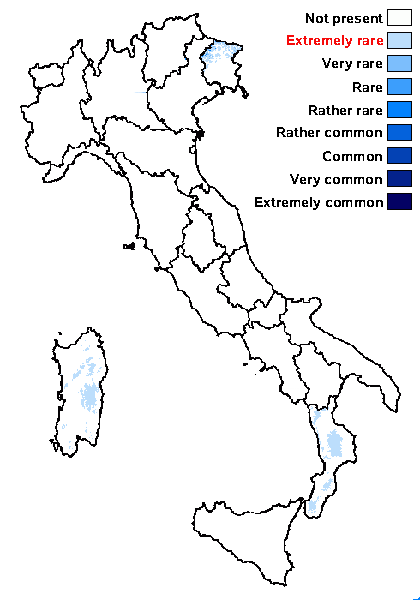
Predictive model
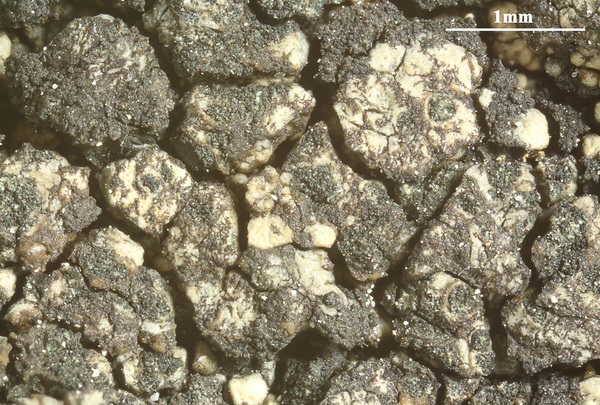
Felix Schumm- CC BY-SA 4.0
[19726], Romania, Distr. Hunedoara, Montes Retezat, lacus Zanoaga, 1900 m, ad saxa granitica. Leg. I, Pišút & A. Vezda, 6.6.1972. VEZDA: LICHENES SELECTI EXSICCATI 1108
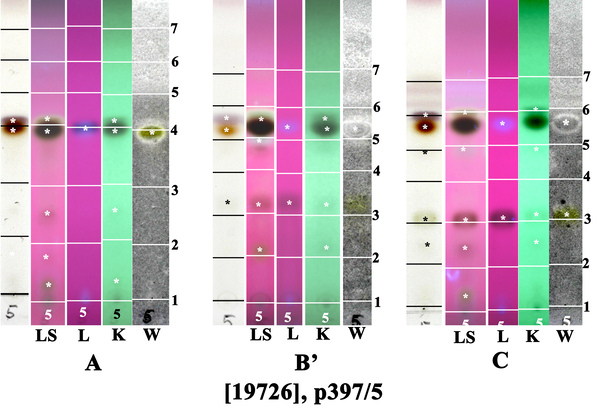
Felix Schumm- CC BY-SA 4.0
[19726], Romania, Distr. Hunedoara, Montes Retezat, lacus Zanoaga, 1900 m, ad saxa granitica. Leg. I, Pišút & A. Vezda, 6.6.1972. VEZDA: LICHENES SELECTI EXSICCATI 1108
1: psoromic acid, 2: miriquidic acid, 3,4: unknown Miriquidica
Growth form: Crustose
Substrata: rocks
Photobiont: green algae other than Trentepohlia
Reproductive strategy: mainly asexual, by soredia, or soredia-like structures (e.g. blastidia)
paras Rhizocarpon geographicum s.lat.
Commonnes-rarity: (info)
Alpine belt: rather rare
Subalpine belt: very rare
Oromediterranean belt: extremely rare
Montane belt: extremely rare
Submediterranean belt: absent
Padanian area: absent
Humid submediterranean belt: absent
Humid mediterranean belt: absent
Dry mediterranean belt: absent

Predictive model

Felix Schumm- CC BY-SA 4.0
[19726], Romania, Distr. Hunedoara, Montes Retezat, lacus Zanoaga, 1900 m, ad saxa granitica. Leg. I, Pišút & A. Vezda, 6.6.1972. VEZDA: LICHENES SELECTI EXSICCATI 1108

 INDEX FUNGORUM
INDEX FUNGORUM
 GBIF
GBIF
 DOLICHENS
DOLICHENS
